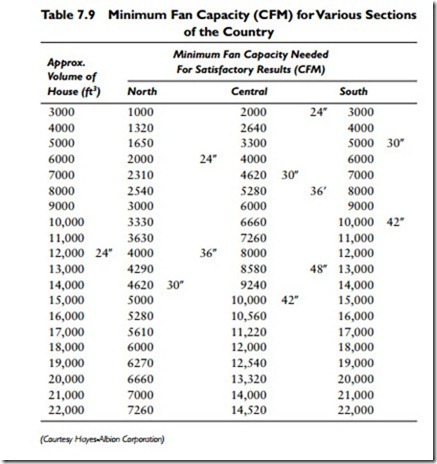Fan Selection
The following information is generally required for the selection of a suitable fan:
1. Volume of air required (cfm)
2. Static pressure (SP)
3. Type of application or service
4. Maximum tolerable noise level
5. Nature of load and available drive
6. Ambient and airstream temperature
7. Mounting arrangement of the system
8. Available line voltage
The volume of air required refers to the volume of air that must be moved by the fan to meet the needs of the building or space. It is expressed in cubic feet per minute and is determined by dividing the total cubic feet of air space by the required number of air changes necessary to give proper ventilation.
The static pressure of a fan may be defined as the total pressure diminished by the fan velocity. In other words, it is the resistance offered by the system (ducts, air intakes, and so on) to the flow of air. After the duct sizes have been determined, it is necessary to calculate the static pressure of the system so that the proper fan can be selected which will handle the desired volume of air (that is, the
required cfm) against the static pressure of the system. The various fan manufacturers provide tables indicating the operating characteristics of various-size fans against a wide range of static pressures. These tables list static pressures for different sizes of various fans.
The type of application (or service) is often an important consid- eration in what kind of fan is used in an installation. For example, a duct system will offer sufficient resistance to require a centrifugal, tubeaxial, or vaneaxial fan. A propeller fan is usually recommended for an installation without a duct system. Other factors, such as the volume of air that must be moved, the allowable noise level, the air temperature, use for general or local ventilation, and cost, are also important considerations in fan selection.
The maximum tolerable noise level is the highest acceptable noise level associated with air exchange equipment. The fan should be of suitable size and capacity to obtain a reasonable operating speed without overworking.
The nature of load and available drive is an important factor in controlling the noise level. High-speed motors are usually quieter than low-speed ones. Either belt- or direct-drive units are used in fan installations, and a high-speed motor connected to the fan with a V-belt offers the quietest operation.
The dry-bulb temperature of either ambient air or exhaust- stream air (ambient or airstream temperature) is a determining fac- tor in selecting a suitable fan. Most fans operate satisfactorily at temperatures up to about 104°F (40°C). Special fans that can oper- ate at higher temperatures are also available. For example, standard belt-driven tubeaxial fans are usable for temperatures up to 200°F (where the motor is out of the airstream).
The mounting arrangement of the system is directly determined by the application or service of the fan. Certain types of fans will prove to be more suitable than others, depending on the kind of installation. Fan manufacturers often offer useful recommendations for mounting arrangements.
The available line voltage will determine the size and type of fan motor most suitable for the installation. Motor voltage designations conform to the following system of voltages now used throughout the country: 115 volts, 230 volts, and 460 volts. Motors for special voltages (that is, 117, 480, or 575 volts) are available on special order.
Fan manufacturers provide information and assistance in selecting the most suitable fan or fans for your installation. Remember that ventilation requirements vary under different climatic conditions, and it is impossible to provide exact rules for determining the
variables of local climate and topography (see Table 7-9). Allowances must be made for these climatic variables.
The following suggestions are offered only as a general guide to the selection of a fan and should not be construed as applying in every situation.
1. Use a 1⁄2 hp, 1⁄3 hp, or 1⁄4 hp 860-rpm direct-drive fan on three-phase motor voltages whenever possible to eliminate the possibility of single-phase magnetic hum.
2. A belt-driven fan is less expensive, less noisy, more flexible, and more adaptable to capacity change than the direct-drive type.
3. Prolonged motor life can be expected of direct-driven fans using other than shaded-pole motors. For that reason, 1550- rpm and 1050-rpm motors should be avoided when very heavy duty and/or extremely long motor life is required.
4. Use a propeller fan when operation offers little or no resis- tance, or when there is no duct system.
5. Use a centrifugal or axial-flow fan when a duct system is involved.
6. Never try to force air through ducts smaller than the area of the fan.
